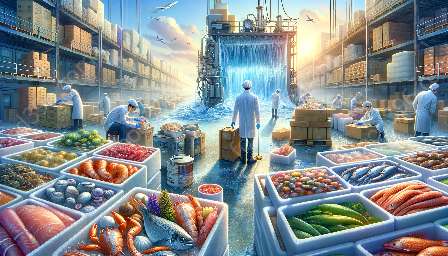Introduction to Seafood Packaging and Storage
Seafood is a highly perishable commodity that requires careful packaging and storage to maintain its safety and quality. Proper handling from catch to consumption is crucial to ensure that seafood products remain safe for consumption. In this topic cluster, we will delve into the critical safety considerations involved in seafood packaging, addressing various factors such as packaging materials, storage conditions, and seafood science.
Importance of Safety in Seafood Packaging
Seafood Safety: Seafood products are susceptible to microbial growth, enzymatic degradation, and oxidation, making safety considerations paramount. Packaging plays a critical role in preventing contamination and spoilage, thereby ensuring the safety of seafood products for consumers.
Consumer Confidence: The safety and quality of seafood packaging directly impact consumer confidence. Effective packaging and storage practices not only preserve the integrity of the product but also instill trust in consumers, leading to repeat purchases and brand loyalty.
Seafood Packaging Materials
When it comes to seafood packaging, the choice of materials is a crucial safety consideration. Packaging materials should be selected based on their ability to protect the product from physical, chemical, and biological hazards, while also offering convenience and shelf appeal.
Types of Packaging Materials: Common packaging materials for seafood include flexible films, rigid plastics, metal cans, and composite materials. Each material has unique properties that impact the packaging's ability to provide a protective barrier and extend the product's shelf life.
Barrier Properties: Impermeability to oxygen, moisture, and light is essential for preserving seafood freshness and preventing lipid oxidation. Packaging materials with high barrier properties contribute to the overall safety and quality of the product.
Storage Conditions
Proper storage conditions are integral to maintaining the safety of seafood products throughout the supply chain. Temperature control, humidity, and protection from contaminants are key factors that influence the shelf life and safety of packaged seafood.
Temperature Management: Seafood is highly sensitive to temperature abuse, which can lead to microbial growth and spoilage. Cold storage facilities and refrigerated transport are essential for preserving seafood freshness and safety.
Hazard Analysis and Critical Control Points (HACCP): Implementing HACCP principles in seafood storage facilities helps identify and mitigate potential hazards, ensuring that the products remain safe for consumption. It involves proactive measures to control critical points in the storage process.
Seafood Science and Safety
The intersection of seafood science and safety considerations is vital for understanding the biological, chemical, and physical aspects of seafood packaging and storage.
Microbiological Considerations: Knowledge of microbial growth and spoilage in seafood products is essential for implementing effective packaging and storage strategies. Factors such as pH, water activity, and the presence of spoilage organisms influence the safety of seafood products.
Oxidative Stability: Seafood contains unsaturated fatty acids that are prone to oxidation, leading to off-flavors and reduced nutritional quality. Packaging materials and storage conditions play a key role in minimizing lipid oxidation and maintaining the safety and sensory attributes of seafood.
Conclusion
In conclusion, safety considerations in seafood packaging encompass a comprehensive approach that addresses the materials, storage conditions, and scientific principles involved in preserving the safety and quality of seafood products. By understanding the critical factors and implementing best practices, stakeholders in the seafood industry can uphold the integrity of their products and meet the highest standards of safety for consumers.

